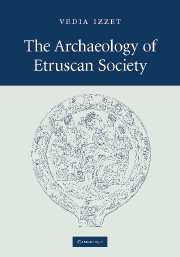Book contents
- Frontmatter
- Contents
- List of illustrations
- Acknowledgements
- List of abbreviations
- Introduction
- 1 Models of change in Etruria
- 2 Etruscan mirrors: reflections on personal and gender identity
- 3 Funerary architecture: the living and the dead
- 4 Sanctuaries: the sacred and the profane
- 5 Domestic architecture: public and private
- 6 Urban form and the concept of the city
- 7 Making Etruscan society: culture contact and (material) culture change
- Bibliography
- Index
- References
Bibliography
Published online by Cambridge University Press: 10 May 2010
- Frontmatter
- Contents
- List of illustrations
- Acknowledgements
- List of abbreviations
- Introduction
- 1 Models of change in Etruria
- 2 Etruscan mirrors: reflections on personal and gender identity
- 3 Funerary architecture: the living and the dead
- 4 Sanctuaries: the sacred and the profane
- 5 Domestic architecture: public and private
- 6 Urban form and the concept of the city
- 7 Making Etruscan society: culture contact and (material) culture change
- Bibliography
- Index
- References
- Type
- Chapter
- Information
- The Archaeology of Etruscan Society , pp. 236 - 308Publisher: Cambridge University PressPrint publication year: 2007



